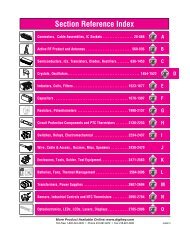Microcontroller Solutions TechZone Magazine, April 2011 - Digikey
Microcontroller Solutions TechZone Magazine, April 2011 - Digikey
Microcontroller Solutions TechZone Magazine, April 2011 - Digikey
Create successful ePaper yourself
Turn your PDF publications into a flip-book with our unique Google optimized e-Paper software.
While MCU suppliers continue to innovate and integrate powerand<br />
battery-saving features, the trend toward energy effi ciency<br />
would not be fully advantageous if the cost and footprint of<br />
the MCU grew substantially. The goal is to help the embedded<br />
developer deliver a lower cost, smaller end product as well as<br />
reduce power consumption. Such solutions must reduce the bill<br />
of materials and device size. The best MCUs will deliver plenty<br />
of performance, integrated connectivity, memory and superior<br />
analog peripherals in the smallest form factors. In other words,<br />
semiconductor suppliers must provide increased functional<br />
density without compromise.<br />
Note the ultra-low-power MCU example in Figure 4 – 64 kB of fl ash<br />
code storage, 4 kB of data RAM, an ADC, and two voltage regulators<br />
(LDO and DC-DC boost convertor) within a 4 mm x 4 mm footprint<br />
(in some cases even smaller). This compact mixed-signal MCU<br />
design allows a complete measurement and interface system on a<br />
single chip without sacrifi cing performance or battery life. Product<br />
designers will be careful to choose MCUs like this with the right set<br />
of peripherals to obtain the optimal cost/performance benefi t.<br />
Embedded developers and product managers are under<br />
continuous pressure to push the envelope of reduced cost, size,<br />
power consumption, and increased performance in their portable<br />
medical device designs. The answer is to use highly integrated<br />
mixed-signal MCUs to deliver products to a market that demands<br />
the very best in performance and affordability in the smallest form<br />
factors. Functionally dense mixed-signal MCUs will provide the<br />
heartbeat for the next generation of portable medical devices, and<br />
health care equipment makers that deliver optimized products that<br />
meet consumer needs will enjoy the benefits of this fast-growing<br />
market segment.<br />
Figure 4: F9xx ultra-low-power MCU architecture.<br />
megaAVR: The Next Step in Capacity and Performance<br />
When your designs need some extra muscle, you need the megaAVR. Ideal for<br />
applications requiring large amounts of code, the megaAVR offers substantial<br />
program and data memories with performance up to 20 MIPS. Innovative<br />
picoPower technology minimizes power consumption. All megaAVRs offer<br />
self-programmability for fast, secure, cost-effective in-circuit upgrades. You<br />
can even upgrade the fl ash while running your application.<br />
Based on industry-leading, proven technology, the megaAVR family offers our<br />
widest selection of devices in terms of memories, pin counts and peripherals.<br />
Choose from general-purpose devices to models with specialized peripherals<br />
like USB, or LCD controllers, or CAN, LIN and Power Stage Controllers. It’s<br />
easy to fi nd the perfect fi t for your project in the megaAVR product family.<br />
Key Features<br />
• Broad family — megaAVR offers our widest selection of devices in<br />
terms of memories, pin counts and peripherals, enabling reuse of code<br />
and knowledge across projects.<br />
• picoPower technology — Selected megaAVR features ultra-lowpower<br />
consumption and individually selectable low-power sleep modes<br />
that make it ideal for battery-powered applications.<br />
• High integration — The megaAVR features on-chip fl ash, SRAM,<br />
internal EEPROM, SPI, TWI, and USART, USB, CAN, and LIN, watchdog<br />
timer, a choice of internal or external precision oscillator, and general<br />
purpose I/O pins, simplifying your design and reducing bill-of-materials.<br />
• Analog functions — Advanced analog capabilities, such as ADC, DAC,<br />
built-in temperature sensor and internal voltage reference, brown<br />
out detector, a fast analog comparator and a programmable analog<br />
gain amplifi er. The high level of integration allows designs with fewer<br />
external analog components.<br />
• Rapid development — megaAVR microcontrollers speed development<br />
with powerful in-system programming and on-chip debug. In addition,<br />
in-system programming simplifi es production line programming and<br />
fi eld upgrades<br />
www.digikey.ca/atmel-mcu<br />
www.digikey.ca/microcontroller<br />
63














